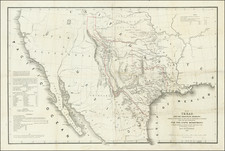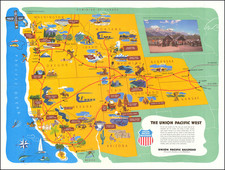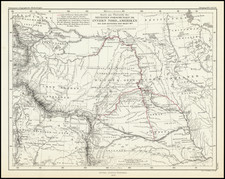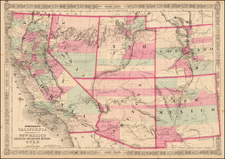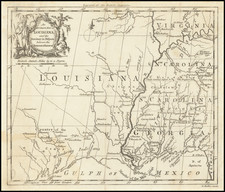Detailed plan of Fort Laramie on the Big Laramie River, likely drawn on the spot in late 1867 or early 1868, most likely under the direction of General W.T. Sherman, during his second visit to Fort Laramie in 1867-68, to oversee the signing of the Fort Laramie Treaty of 1868.
The plan provides a remarkable historical look at Fort Laramie, depicting both the original adobe quadrangle acquired by the US from the fur traders of the American Fur Company in 1849 (which was all but destroyed within a few years) and the structures which existed as of the time of the Fort Laramie Treaty of 1868. The structures included Brown's Hotel, a Telegraphic Office, Theater, Billiard Room, Bakery, and Print Shop, along with the usual assortment of buildings to be expected at a western fort, including Barracks, Stables, Officers Quarters, Guard House, Blacksmith's Shop, Carpent's Shop, Kitchen, Laundry. Hospital and 2 Ice Houses. In his history of Fort Laramie, Merrill Mattes notes also the construction of a "long circular ditch, " which appears in the plan at the north part of the diagram, beyond the Graveyard, which was:
constructed in 1865 by the Eleventh Ohio Cavalry to connect battery redoubts thrown up as insurance against Indian attack while Colonel Collins was absent with his command on the relief of Mud Springs Station. Evidently the temporary fortification was strung along the plateau and bottoms to the north of the fort, which would have been the section most vulnerable to surprise attack. A more permanent fortification was built by regular troops of the Second Cavalry in 1866, also in the bottoms to the north.
Perhaps the most interesting appearance on the plan is Sutler's (Store or Post Trader) and Sutler's residence, the civilian residence and trading post established in 1849. In his history of Fort Laramie, Mattes notes that the Sutler's Store:
existed from 1849 right on through, never migrating, but undergoing constant accretions and redesigns; yet it is veiled in mystery because most of the business records have been lost, and the building was never accounted for in the Quartermaster's annual inspections.
The plan can be dated to within a short window of time between 1867 and 1868. The key in the bottom left shows distances to Fort Laramie, Fort Fetterman and Fort Reno. Fort Reno was abandoned by the US in March 1868 and burned to the ground by the Sioux Chief Red Cloud in August 1868, prior to the signing of the Fort Laramie Treaty of 1868. Fort Fetterman was constructed in July 1867 (named for Captain William J. Fetterman, who had been killed in December 1866) and was excluded from the Treaty of Fort Laramie, which resulted in the abandonment of Fort Reno, Fort Phil Kearny and Fort C.F. Smith. Accordingly, the drawing shows a plan of Fort Laramie between mid 1867 and March 1868, at which time Fort Reno was officially abandoned.
Based upon the foregoing, and the arrival of General W.T. Sherman and the Indian Commission in November 1867, for the purpose of negotiating a peace treaty with the Sioux, it would seem logical that the plan was drawn between November 1867 and March 1868. Sherman had previously inspected the post in August 1866, observing that there was "a mixture of all sorts of houses of every conceivable pattern and promise scattered about." The annotation showing the quarters constructed in 1867 in the main square supports the dating which we propose, as it suggests the addition of a new structure that Sherman would not have observed in his August 1866 visit.
The present plan is one of the earliest surviving diagram of Fort Laramie. Mattes identifies Captain Luhn's report of 1870 military structures as the earliest extent detailed analysis of the surviving structures at Fort Laramie. If accurate, this would suggest that the present plan is in fact the earliest extent diagram of Fort Laramie, as the only other descriptions of the fort described by Mattes are those of early travellers and the Sherman's report in August 1866.
There may in fact exist other extent copies of the map or similar maps, as we were able to locate a modern diagram of the Fort, which purports to be a copy of a map from 1867, which is substantially similar to our map: www.cr.nps.gov/history/online_books/hh/20/images/hh20m3.jpg, which is apparently based upon illustration titled Fort Laramie, D.T. General Plan, March 1867, which survives in a redrawing for the National Park Service by C.W. Nichols, from an original photostatic copy owned by Paul Henderson (OCLC 367448445). We note however, that our map locates a garden in the upper left section, whereas the diagram shows the areas as Indian Lodges. Our map also shows the Quartermaster's Departement opposite the Hay Yard, with a row of buildings including the Blacksmith Shop, Carpenter Shop, Print Shop, and a number of other buildings which are not show on the modern diagram.
Fort Laramie existed from 1834 to 1890, at the junction of the Laramie and North Platte Rivers, in Eastern Wyoming. Originally established by William Sublette as Fort William in 1834, and later renamed Fort John in 1841, Fort Laramie would serve as a log stockade, adobe trading post, and evolving military post. Explorers, trappers, traders, missionaries, emigrants, freighters, Pony Express riders, stage drivers, cowboys, and homesteaders, as well as soldiers and Indians, all utilized Fort Laramie as a a landmark of great importance.
The first visit to the mouth of Laramie Fork was by a party of 7 men of the American Fur Company led by Robert Stuart, taking dispatches from the new post of Astoria at the mouth of the Columbia River to St. Louis, by way of Jackson's Hole, South Pass, and the Platte. On December 22, 1812 Stuart noted in his journal that here "a well wooded stream apparently of considerable magnitude came in from the South West."
The name Fort Laramie derives from a French Canadian Fur Trapper, Jacques Laramee or Laramie. According to an 1831 report by Indian Agent John Dougherty at Fort Leavenworth this was "J. Loremy, a free man" killed in 1821 by Arapahoe Indians "on the Platte." As the Fur Trade evolved, an important rendezvous point became Salt Lake. In 1832, William Sublette and Robert Campbell formed a trading partnership, contracting to supply others at the rendezvous. In 1834 they built the first Fort on the Laramie River.
As the trade in the west evolved from furs to Buffalo, the partners recognized the need for a storage point for Buffalo pelts. "Laramais' Point," at the confluence of the Laramie and North Platter Rives, was the site named in their trading license. The location had many natural advantages as well as being roughly equidistant from the
Missouri River steamboat landings and the Upper Green River. This inspired the birth of Fort Laramie, which would soon become the capital of a fur trade empire, rivalled in importance only by Bent's Fort on the Santa Fe Trail, and Fort Union on the Upper Missouri.
in 1835, Sublette and Campbell sold Fort William to Jim Bridger, Thomas Fitzpatrick and Milton Sublette. In 1836, the group was persuaded to relinquish their interest to the American Fur Company. Fort William enjoyed a virtual monopoly on trade in the region until 1841, when Lancaster P. Lupton constructed Fort Platte on the right bank of the North Platte, about 1 mile upriver from the confluence of the North Platte and the Laramie River. The new fort prompted the American Fur Trade Company to abandon the original Fort William structure, which was named Fort John, in honor of John B. Sarpy. Among the visitors to Fort John who wrote eye witness descriptions were Rufus Sage (1841), John C. Fremont (1846), Francis Parkman (1846) and Howard Stansbury (1849).
The the mid-1840s, Fort Laramie had also become of the major stopping off points on the route west, including thousands of settlers in route to Oregon and Mormon pioneers headed to Salt Lake (Brigham Young passed through Fort Laramie in June, 1847. In March, 1849, the US Government established its second western fort at Fort Laramie. Lieutenant Daniel P. Woodbury of the Corps of Engineers was authorized to purchase the buildings of Fort Laramie "should he deem it necessary to do so." Companies A and E, Mounted Riflemen, and Company G, Sixth Infantry, were designated as the first garrison of the new post. After a brief reconaissance of the area looking for a better site, the site was purchased from the American Fur Company for $4,000. Shortly thereafter, it became a major stop for the wave of 49ers headed for California.
With the outbreak of the Civil War, the garrison at Fort Laramie was significantly reduced, leading to a period of Indian Raids on the towns and settlements in the region. A period of war between with Indians commenced in 1865. A peace Treaty was briefly reached at Fort Laramie in June, 1866, but the arrival of Colonel Henry Carrington with 2,000 troops during the ceremonies led to with Sioux withdrawal from the Treaty, led by Chief Red Cloud. For the next 18 months, the Indian War continued.
In July 1867, Congress established another Commission to push for peace with the Indians and was dispatched to Fort Laramie, under the General W.T. Sherman. The Sioux refused to meet with Sherman until the garrisons at Fort Reno, Fort Phil Kearny and Fort C.F. Smith were withdrawn. The abandonment of these 3 forts was approved in March 1868 and officially abandoned in August 1868, at which time they were burned to the ground by Red Cloud. Shortly thereafter, the Fort Laramie Treaty of 1868 was entered, granting to the Sioux as a reservation all of what is now South Dakota west of the Missouri River. It also gave them hunting rights in the great expanse north of the North Platte and east of the Bighorn Mountains, designated as unceded Indian lands. The First Red Cloud Agency was established in 1871 on the North Platte, just 25 miles below the fort, at the present Nebraska-Wyoming line. In 1873 it was moved north to a site on White River in northwestern Nebraska.









